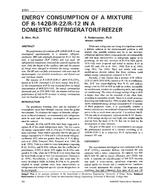Track: Refrigeration
Sponsor: 3.3 Refrigerant Contaminant Control, 3.2 Refrigerant System Chemistry, 3.4, MTG Low GWP
Chair: Ed Hessell, Ph.D., Associate Member, Chemtura Corp., Fords, NJ
This seminar discusses some of the near term and long term low global warming potential refrigerant options for retrofits in select applications. Also presented is information on lubricant considerations during retrofits as well as practical recommendations for avoiding contamination during the retrofit process.
1. Lubricant Considerations during Retrofits to Low GWP Refrigerants
Joe Karnaz, DSc, Member, Shrieve Chemical, Houston, TX
Transitioning of refrigerants involves a great deal of consideration, particularly for new product implementation. OEM’s tests units to make sure system performance is at least maintained. Sometimes new refrigerant developed for OEM operation doesn’t always mean it will work effectively for retrofit situations. One particular detail that needs investigation, is will the retrofit refrigerant work effectively with lubricant that was formerly used in the unit. Previous refrigerant transitions showed some additional manipulation of the lubricant was needed. Today there is another transition to using lower GWP refrigerants which will once again require evaluation of the lubricant in retrofit situations.
2. Impact of Contamination on the Stability of Low GWP Refrigerants
Sarah Kim, Ph.D., Associate Member, Arkema, Inc., King of Prussia, PA
Servicing with low GWP refrigerants is becoming common in the HVAC&R industry due to the phase out of conventional refrigerants. It is important to follow best practices such as refraining from mixing refrigerants and using the recommended lubricants while considering that HFOs will exhibit a different nature than HFC or HCFC refrigerants. This session covers the impact of common contaminants that may influence the system performance and reliability of some very low GWP refrigerants containing unsaturated molecules such as R-1234yf and R-1233zd(E). In addition, stabilizers which can prevent the deterioration of performance due to contaminants is discussed.
3. Key Learnings from Conversions of Commercial Refrigeration Systems to Low GWP Alternatives
Andrew Pansulla and Charles Allgood, Ph.D., Chemours, Wilmington, DE
The search for replacements for HCFC and HFC based refrigerants such as R-22 and R-404A, being phased out globally due to stratospheric ozone depletion and global warming potential issues, has led to the development of low GWP HFO blend alternatives, such as R-449A. This presentation includes the retrofit procedure for HFO refrigerants in low and medium temperature commercial refrigeration systems that were originally designed for HCFC and HFC refrigerants. Also, data obtained during actual system conversions, including compatibility with seals/lubricants as well as operational and energy performance is reported.
Presented: June 26, 2017, 8:00-9:30 AM
Run Time: 90 min.
This is a zip file that consists of PowerPoint slides synchronized with the audio-recording of the speaker (recorded presentation), PDF files of the slides, and audio only (mp3) for each presentation.
Citation: ASHRAE Seminar Recordings, 2017 ASHRAE Annual Conference, Long Beach , CA
Product Details
- Published:
- 2017
- Units of Measure:
- Dual
- File Size:
- 1 file , 81 MB
- Product Code(s):
- D-LB17Sem23


